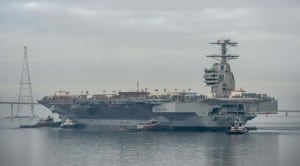
The Thursday Senate Armed Services Committee hearing on the Ford-class carrier, which has been dogged by ballooning costs and schedule delays, turned into a referendum on acquisition reform.The USS Gerald R. Ford (CVN-78) is more than $2 billion over its initial budget, and a Government Accountability Office report released yesterday stated that further cost overruns are likely. The director of the Pentagon’s independent weapons testing office, Michael Gilmore, testified that several of the developmental systems on the ship—such as the…













